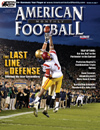Article CategoriesAFM Magazine
|
Shore Up Your Secondary – AFM’s compilation of tactics, drills and strategies to make your secondary your primary line of defense.© More from this issueIf you’re heading into post-season play, you’re likely to face a situation where your defensive backfield is forced to come up with a big play. If you’re ahead late, your secondary will be tested in coverage when your opponent goes to the air game. If you need to get the ball back to mount a last-minute offensive of your own, you’re going to need your defenders to prevent the other team from getting game-clinching first downs. Either way, your secondary can mean the difference between your team advancing or going home.
|
|
|||||||
| HOME |
MAGAZINE |
SUBSCRIBE | ONLINE COLUMNISTS | COACHING VIDEOS |
Copyright 2025, AmericanFootballMonthly.com
All Rights Reserved





